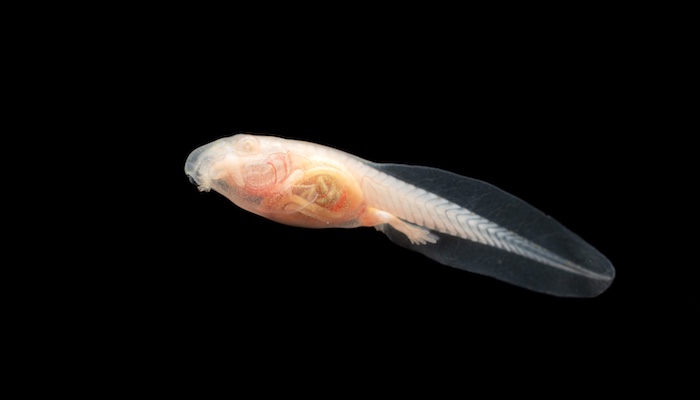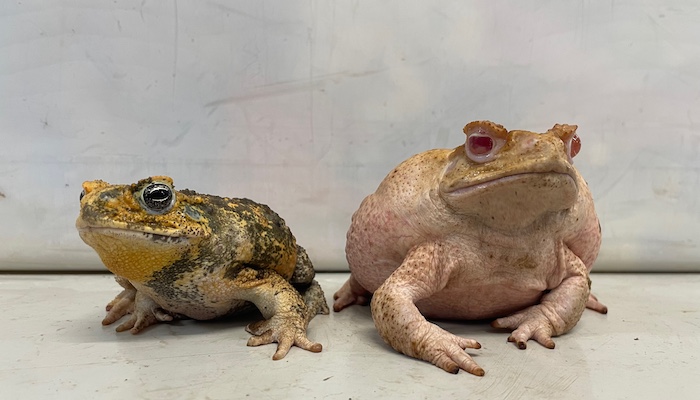Albino cane toads created using gene-editing technology reveal that albino animals face competitive disadvantages going far beyond their vulnerability to predators, according to new research published in Proceedings of the Royal Society B.

Pale problem: Gene-edited albino tadpole albove shows why colourless animals struggle from birth.
The study, led by Macquarie University PhD candidate Alexander Funk, is the first to use a gene-editing technique (CRISPR) to 'knock out' or disable specific genes in cane toads – animals not typically used in laboratory research.
The researchers tested a long-held belief that albino animals are rare mainly because predators can easily spot and kill them.
"Other studies have shown that albino animals tend to have reduced visual abilities as the condition is linked to poor stereoscopic vision," says Funk. "We were curious how this poor vision might affect them, because cane toads are visual foragers, especially in their adult stage."
Beyond predation vulnerability
Traditional evolutionary theory suggests albino animals are rare because their lack of camouflage makes them easy targets for predators.
But the team's experiments, comparing albino and pigmented siblings in controlled environments without predators, revealed a more complex story.
The albino tadpoles were less likely to survive and changed into adult toads faster when competing with non-albino siblings for food and space. Adult albino toads grew more slowly when living with pigmented toads and had much more difficulty catching prey.

Same parents, different genes: New toad research has shown albino toads needs brighter light to hunt.
"That surprised us – we expected to see the intense competition in the adult stage, but we didn't expect to see it come out so clearly in its effects on survival in the tadpole stage," Funk says.
The team also tested toads' hunting abilities, dropping live termites in their containers and comparing what happened under different lighting conditions.
The tests revealed the problem: poor eyesight. Albino toads needed much brighter light to catch their prey successfully – and missed more targets than their pigmented siblings.
Most toads feed at night, so these findings also suggest that in nature, albino toads would struggle to compete for resources during crucial developmental stages, Funk adds.
Experimental control methodology
The study has a broader significance: CRISPR technology can help scientists to tackle big questions about how evolution works.
The researchers created siblings that only differed in pigmentation, removing the usual problems of studying naturally occurring albino animals.
"We can now apply this emerging power to manipulate the genetic features of animals, to ask fundamental questions in evolutionary biology," says Professor Rick Shine, evolutionary biologist and ecologist at Macquarie University who supervised the research.
"By knocking out just one gene, we can directly compare siblings; same clutch of eggs, same parents – the only difference is we've disabled the gene for pigmentation."
Naturally occurring albino animals may carry multiple genetic differences independent of pigmentation that make comparisons with unrelated normal-coloured individuals difficult, he says.
"This is the first study I'm aware of that looks at the effect of albinism on competition, rather than on being susceptible to predators," says Funk. "There's very few studies on albino animals generally, as they are really rare in the wild."
Conservation and control – and future research
The findings have immediate practical effects for the team's cane toad control program.

Toad tracker: Evolutionary biologist Rick Shine, pictured with albino toad, headed up a gene-editing project that challenged albinism theories.
"Should we get to the point where we release Peter Pan tadpoles in a controlled fashion in the wild, we could give them a distinctive colour so that we can better track their impacts," says Professor Shine.
"But if albino tadpoles won't survive, we need to rethink that."
Alternative options could include developing xanthic toads (lacking yellow pigment) or leucistic toads (pale bodies with normal-coloured eyes) – creating toads that don't have the disadvantages of albinism, but which can still be distinguished from the original invasive species.
Co-author Dr Chris Jolly says the external fertilisation and large clutch sizes of cane toads make them ideal subjects for CRISPR changes that would be far more challenging in mammals or other vertebrates with internal development.
"As gene-editing technology becomes cheaper and more accessible and affordable, these molecular tools mean we can test long-standing theories about natural selection and survival. Similar approaches could help resolve other evolutionary puzzles," he says.
"While this study is interesting in and of itself, it is also a case study that shows a new way to use CRISPR for evolutionary biology," says Dr Jolly.
The study 'Knocking out genes to reveal drivers of natural selection on phenotypic traits: a study of the fitness consequences of albinism' is published in Proceedings of the Royal Society B.
Professor Rick Shine and Dr Chris Jolly are behavioural ecologists and evolutionary biologists in Macquarie University's School of Natural Sciences.






